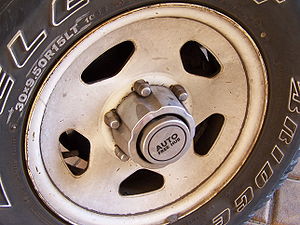
Locking hubs
Encyclopedia

Four-wheel drive
Four-wheel drive, 4WD, or 4×4 is a four-wheeled vehicle with a drivetrain that allows all four wheels to receive torque from the engine simultaneously...
vehicles, allowing the front wheels to be manually disconnected from the front half shaft
Half shaft
The term half shaft is another name for a front-wheel drive shaft, which is also called the constant velocity axle or CV axle. There is one half shaft per wheel. Some may further to this part as a CV shaft....
s.
Many four wheel drive vehicles, especially heavy duty 4×4 trucks, do not have a center differential
Differential (mechanics)
A differential is a device, usually, but not necessarily, employing gears, capable of transmitting torque and rotation through three shafts, almost always used in one of two ways: in one way, it receives one input and provides two outputs—this is found in most automobiles—and in the other way, it...
or equivalent (e.g., a viscous coupling), should only be used in four wheel drive mode when traction
Traction (engineering)
Traction refers to the maximum frictional force that can be produced between surfaces without slipping.The units of traction are those of force, or if expressed as a coefficient of traction a ratio.-Traction:...
is limited, otherwise transmission wind-up can occur. This is known as a part time, four wheel drive system. Because of this, many of these vehicles will spend most of their time in two wheel drive, and locking hubs allow elements of the drivetrain that are not needed in two wheel drive to be disconnected. With the hubs disengaged and the transfer case in 2WD, the whole front axle and differential are inactive.
Without locking hubs, the front wheels would turn the front half shafts, which would turn the front differential and driveshaft. Locking hubs, when switched appropriately, will allow the front wheels to turn independently of the drivetrain.
Suggested benefits of locking hubs include better fuel efficiency
Fuel efficiency
Fuel efficiency is a form of thermal efficiency, meaning the efficiency of a process that converts chemical potential energy contained in a carrier fuel into kinetic energy or work. Overall fuel efficiency may vary per device, which in turn may vary per application, and this spectrum of variance is...
, quieter operation, less vibration, and lower wear, however there are no reliable scientific studies to prove these claims. Exactly how great these benefits are is open to debate, with many feeling that they are outweighed by the disadvantages below.
In older vehicles, manual locking hubs are used to disengage the front wheels. This requires getting off the vehicle to engage or disengage the front wheels. If road conditions are irregular, these vehicles can be used in 2WD mode with the locks engaged (by disengaging 4WD with the internal lever or switch) and 4WD needs only to be engaged when road conditions require it.
In more modern 4WD vehicles, automatic locking hubs are often used, which as the name implies engage automatically when 4WD is activated from the inside of the vehicle. The main advantage is that the driver does not need to leave the vehicle to activate 4WD or drive the vehicle in 2WD with the front axle engaged. The disadvantage with this system is that most designs require the vehicle to move some distance (usually a whole wheel turn, normally in a specific direction) in order for the hubs to engage or disengage (in many cases 4WD can be engaged with the vehicle in movement). This might not be possible if the vehicle gets completely stuck before engaging 4WD, so automatic hubs require more caution on the driver's part.
Disadvantages of locking hubs include the fact that it is necessary to leave the vehicle to engage them in the manual case, and the need to plan ahead and engage 4WD before getting stuck in the case of automatic hubs. It is also considered that the exposed hub locks can be broken or damaged by off road conditions, rendering 4×4 useless and leaving the vehicle stranded. Also, in some axle designs (such as those used on older Land Rover
Land Rover
Land Rover is a British car manufacturer with its headquarters in Gaydon, Warwickshire, United Kingdom which specialises in four-wheel-drive vehicles. It is owned by the Indian company Tata Motors, forming part of their Jaguar Land Rover group...
s), the top swivel bearing can become starved of lubrication, which is normally supplied by oil which is thrown up by the axle, unless the hubs are locked every few hundred miles. Since locking hubs generally do not require a key to operate, they can also be maliciously locked or unlocked by persons other than the vehicle owner.

